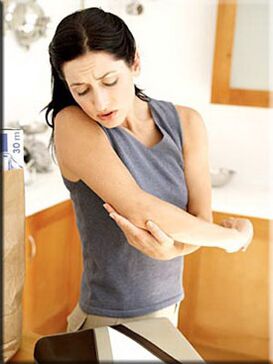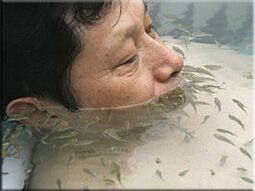Psoriasis can manifest in various forms.Psoriasis options include vulgar (simple, common) or, otherwise, plaque psoriasis (vulgaris psoriasis, plaque psoriasis), pustular psoriasis, form or point psoriasis, flexible psoriasis) (flexible psoriasis).This section offers a brief description of each variety of psoriasis together with its code according to the international classification of diseases (ICD-10).

Plush's psoriasis, or Common psoriasis, vulgar psoriasis, simple psoriasis (psoriasis vulgaris) It is the most common form of psoriasis.It is observed in 80% - 90% of all patients with psoriasis.Plush -shaped vulgar psoriasis is most often manifested in the form of typical areas raised on the surface of the healthy skin of inflamed, red, hot skin or silver white, lightly examined, scaly and thick skin.Red skin under a layer of gray or silver is easily removed is easily injured and bleeding, as it contains a large number of small vessels.These areas of typical psoriatic damage are called psoriatic plaques.Psoriatic plaques tend to grow in size, join neighboring plates, forming entire plates ("paraffin lakes").
Psoriasis of the surfaces of the flexion (flexible psoriasis), or "Reverse psoriasis". It usually looks like smooth, not peel or minimal peel, inflamed red spots that are not particularly elongated on the surface of the skin, located exclusively on skin folds, in absentia or minimal lesions of other areas of the skin.Most often, this form of psoriasis affects folding in the external genitals, groin, in the inner surface of the buttocks, axillary depressions, folding under an overweight (psoriatic pannus), and in the folding of the skin under the mom's glands in women.This form of psoriasis is particularly susceptible to deterioration under the influence of friction, skin damage and sweat, and is often associated or complicated by a secondary fungal infection or streptococcal pyodermas.
Guttate psoriasis (guttate psoriasis) It is characterized by the presence of a large small amount, raised on the surface of healthy, dry, red or purple skin (to purple), similar in spots, tears or small spots, circles of lesion elements.These psoriatic elements usually strengthen large surfaces of the skin, most often butt, but can also be observed in the legs, forearm, shoulders, scalp, back, neck spastra.Earth -shaped psoriasis often develops or worsens after streptococcal infection, in typical cases - after streptococcal tonsillitis or streptococcal pharyngitis.
Pustular psoriasis OR Psoriasis of exudation It is more severe than the skin forms of psoriasis and looks like bubbles or bladder raised on the surface of the healthy skin, filled with unfortunate, transparent inflammatory exudates (pustula).The skin below and above the surface of the pustules and around them is red, hot, edematous, inflamed and thick, easily exfoliates.Secondary pustules infection can be observed, in this case the exudate acquires a purulent character.Pus psoriasis can be limited, localized, while its most common localization is the distal ends of the limbs (arms and feet), that is, the lower leg and forearm, this is called palmoplantic pustules (palmoplantar pustulosis).In other cases, more severe, pustular psoriasis can be generalized, with the widespread spread of pustules over the entire surface of the body and the tendency to join in larger pustules.
Causes of psoriasis
Damaged function of skin barriers (in particular, mechanical trauma or irritation, rubbing and pressure on the skin, soap and cleaner abuse, contact with solvents, household chemicals, alcohol -containing solutions, the presence of skin -infected focuses or skin allergies, dry skin) also play a role in the development of psoriasis.
Psoriasis - This is in many ways an idiosyntatic skin disease.The experience of most patients suggests that psoriasis can be spontaneously improved or, conversely, deteriorate without any obvious reason.Studies of various factors related to the emergence, development or deterioration of psoriasis tend to be based on the study of the small hospital, usually (not patients), that is, obviously more severe, groups of patients with psoriasis.Therefore, these studies often suffer from insufficient representation of the sample and the inability to identify causal relationships in the presence of a large number of other factors (including unknown or unconfigured) that may affect the nature of the course of psoriasis.Often, in various studies, there are contradictory findings.However, the first signs of psoriasis often appear after undergoing stress (physical or mental), skin damage at the first appearance of psoriatic rashes, and/or transferred streptococcal infection.Conditions, according to a number of sources that can contribute to the irritation or deterioration of the course of psoriasis, include acute and chronic infections, stress, climate change and seasons change.Some medicines, in particular, lithium carbonate, beta-blockers, antidepressants, antimalarial, anticonvulsants, according to a number of sources, are associated with a deterioration in psoriasis or may even provoke its primary appearance.Excessive alcohol consumption, smoking, overweight or overweight, improper nutrition can weigh the flow of psoriasis or complicate its treatment, provoke irritation.Hair spray, some creams and gloves for hand, cosmetics and perfumes, household chemicals can also provoke an irritation of psoriasis in some patients.

Patients suffering from HIV or AIDS infection often suffer from psoriasis.This seems to be paradoxical for psoriasis researchers, as treatment aimed at reducing T cell number or their activity generally helps treat psoriasis, and HIV infection or, moreover, AIDS is associated with a decrease in T cell number.CD4+ T, psoriasis in patients with infected HIV or patients with AIDS worsen.In addition to this puzzle, HIV infection is usually associated with a strong displacement of the cytokine profile to TH2, while vulgar psoriasis in non -infected patients is characterized by a strong displacement of the cytokine profile to TH1.According to the currently approved hypothesis, a reduced amount and pathologically altered activity of TD4+ lymphocytes in patients with HIV or AIDS infection cause hyperaactics of CD8+ T-lymphocytes, which are responsible for developing or deteriorating psoriasis in HIV or AIDS patients.However, it is important to know that most patients with psoriasis are healthy about HIV cart, and HIV infection is responsible for less than 1 % of cases of psoriasis.On the other hand, psoriasis in people infected with HIV occurs, according to various sources, with a frequency of 1 to 6 %, which is approximately 3 times higher than the frequency of psoriasis in the general population.Psoriasis in patients with HIV infection and especially AIDS often continues extremely difficult, and is poorly borrowed or not suitable for standard methods of therapy.
Psoriasis most commonly develops in patients with initially dry, thin, sensitive skin than in patients with oily skin or well denied, and is much more common in women than in men.In the same patient, psoriasis most often occurs first in areas of dry or thinner skin than in oily skin, and especially occurs often in places of damage to the skin, including combing, abrasions, scratches, cuttings, in places undergoing friction, pressure or contact with aggressive chemicals, detergents, detergents.(This is called Kebner's phenomenon).It is assumed that this lesoride phenomenon psoriasis is mainly with dry, thin or damaged skin associated with infection with the fact that the body infects (perhaps most often streptococci) easily penetrates the skin with minimal secretion of skin fat (which, under other conditions, protect the skin from infections) or in the presence of skin damage.The most favorable conditions for the development of psoriasis are thus opposite to the most favorable conditions for the development of fungal infection (so -called "athlete foot") or armpits, inguinal region.For the development of fungal infections, the most favorable, wet skin, for psoriasis, on the contrary, dry. InfectionThat has penetrated dry skin causes chronic dry inflammation (not -ancient), which, in turn, causes characteristic symptoms of psoriasis, such as itching and increased skin cell spread.This, in turn, leads to further growth of the skin, both due to inflammation and increased proliferation of keratinocytes, and due to the fact that the infected body consumes moisture, which would otherwise serve to hydrate the skin.To avoid excessive skin dryness and reduce the symptoms of psoriasis, patients with psoriasis are not recommended to use washing clothes and cleansing, especially solid ones, as they not only damage the skin, leaving microscopic scratches, but also scrap from the skin, upper protective cornea and skin.It is also recommended to use a tallcum or puffing for children after washing or bath to absorb excess moisture from the skin, which, otherwise, will "take" an infected agent.Moreover, it is recommended to use products that hydrate and nourish the skin, and lotions that improve the function of the sebaceous glands.It is not recommended to abuse soap, cleaners.You should try to avoid skin contact with solvents, household chemicals.
Diagnosis of psoriasis
The diagnosis of psoriasis is usually simple and is based on a characteristic appearance of the skin.There are no diagnostic procedures or blood tests specific to psoriasis.However, with active, progressive psoriasis or its severe course, deviations can be found in blood tests, confirming the presence of an active inflammatory, autoimmune, rheumatic process (increasing rheumatoid factor titles, acute phase proteins, leukocytosis, ESR, etc.)Histological confirmation (verification) of the diagnosis of psoriasis.During a biopsy of the patient with psoriasis, groups of so-called retail tears, obesity of a keratinocyte layer, their histological immaturity, mass infiltration of the skin with t-lymphocytes, macrophages and dendritic cells, increased keratinocyte and cell-spreading signs, cells, cells, cells.of entry.of skin under the skin under a layer of skin under a layer of skin under a layer of skin under a layer of skin under a layer of skin under the pluts.Another characteristic sign of psoriasis is point hemorrhages and ease of skin bleeding under the plaque during its scrambling, which is associated with both the acceleration of angiogenesis and with the pathologically increased and fragile permeability of the skin vessels in lesions (Aushpitz symptoms).
Alternative treatment of psoriasis
For the symptomatic treatment of vulgar psoriasis, some of the countries in some countries use ichthyotherapy in some resorts with open thermal resources.Garra Rufa fish that live there eat the skin on psoriatic plaques, without touching healthy areas.After such treatment, an improvement in patients' condition is observed from six months or more.A successful location in subtropics allows you to combine rest in comfortable hotel rooms with fish bath procedures and sea baths.At your request, the hotel chef will prepare a special diet.Water in a bathroom with Garra Rufa fish passes a three -stage cleaning system (mechanical, ultraviolet sterilization and biological cleaning).The sun, the sea, the fresh air, the special diet-all these in the complex help to achieve a positive effect of miraculous fishing baths.Daily spraying with a mixture of powdered sugar and potato starch will help remove psoriatic plates.
Treatment of psoriasis with popular remedies
- To cope with psoriasis, Give up fat, pork, smoking, chocolate, spices, alcohol, coffee and sweets.Enrich the diet with fermented dairy products, fresh herbs, baked apples, fish and nettle salads.Eat many vegetable oils rich in necessary fatty acids) and products containing lecithin.
- Eat food In boiled, boiled or boiled (excluded fried and smoked) from the diet.
- Reject food that increase acidity in the body- Prioritize products that alkalize the body.Some people online have repeatedly proven that only a change in food in terms of alkalization contributed to complete restoration of health, not only by psoriasis itself, but also of old chronic diseases.
- clean Only baby soap or pitch, regularly taking the bathroom with celandine decoction, hops and three -color violets.
- FOLLOWED Surgery (1-2-day hunger).























